
PeerTube is a free and open-source, decentralized, ActivityPub federated video platform powered by WebTorrent that uses peer-to-peer technology to reduce load on individual servers when viewing videos. In this step by step guide I will show you how to install PeerTube on your Synology NAS using Docker and Portainer.
This guide works perfectly with the latest PeerTube v7.2.1 release.
STEP 1
Please Support My work by Making a Donation.
STEP 2
Install Portainer using my step by step guide. If you already have Portainer installed on your Synology NAS, skip this STEP. Attention: Make sure you have installed the latest Portainer version.
STEP 3
Make sure you have a synology.me Wildcard Certificate. Follow my guide to get a Wildcard Certificate. If you already have a synology.me Wildcard certificate, skip this STEP.
STEP 4
Go to Control Panel / Login Portal / Advanced Tab / click Reverse Proxy. Follow the instructions in the image below.
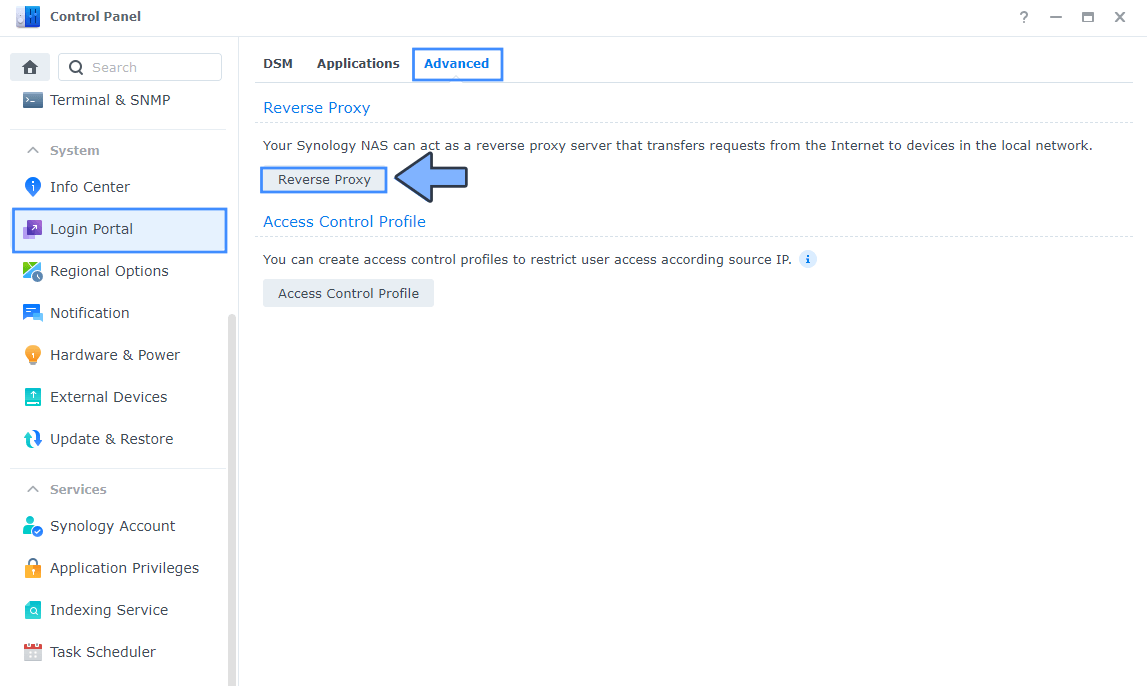
STEP 5
Now click the “Create” button. Follow the instructions in the image below.
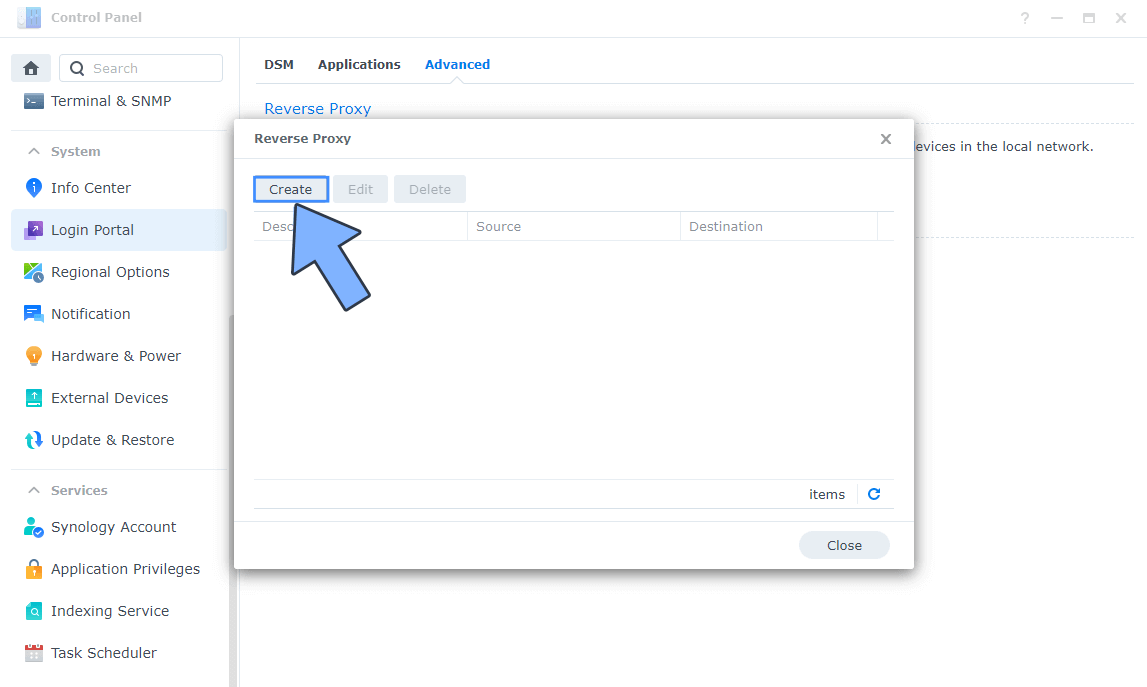
STEP 6
After you click the Create button, the window below will open. Follow the instructions in the image below.
On the General area, set the Reverse Proxy Name description: type in PeerTube. After that, add the following instructions:
Source:
Protocol: HTTPS
Hostname: peertube.yourname.synology.me
Port: 443
Check Enable HSTS
Destination:
Protocol: HTTP
Hostname: localhost
Port: 9510
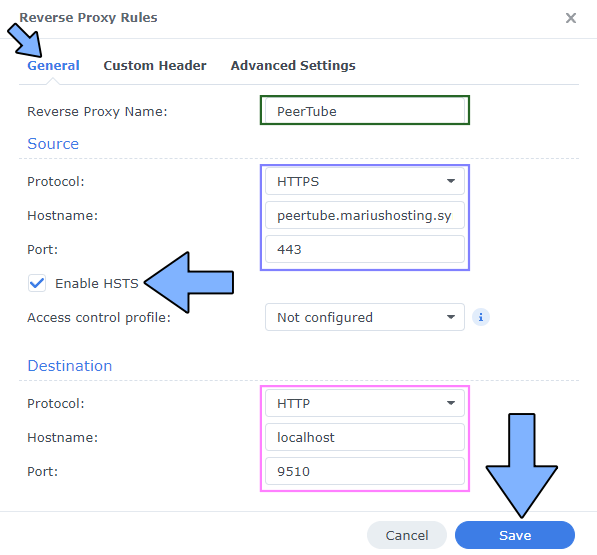
STEP 7
On the Reverse Proxy Rules click the Custom Header tab. Click Create and then, from the drop-down menu, click WebSocket. After you click on WebSocket, two Header Names and two Values will be automatically added. Click Save. Follow the instructions in the image below.

STEP 8
Go to Control Panel / Network / Connectivity tab/ Check Enable HTTP/2 then click Apply. Follow the instructions in the image below.
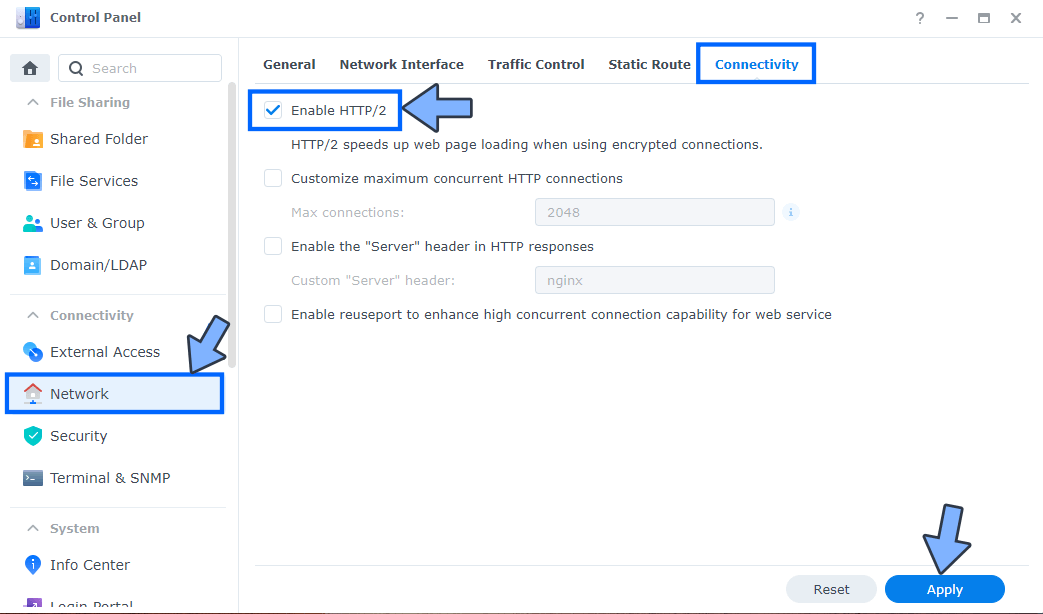
STEP 9
Go to Control Panel / Security / Advanced tab/ Check Enable HTTP Compression then click Apply. Follow the instructions in the image below.
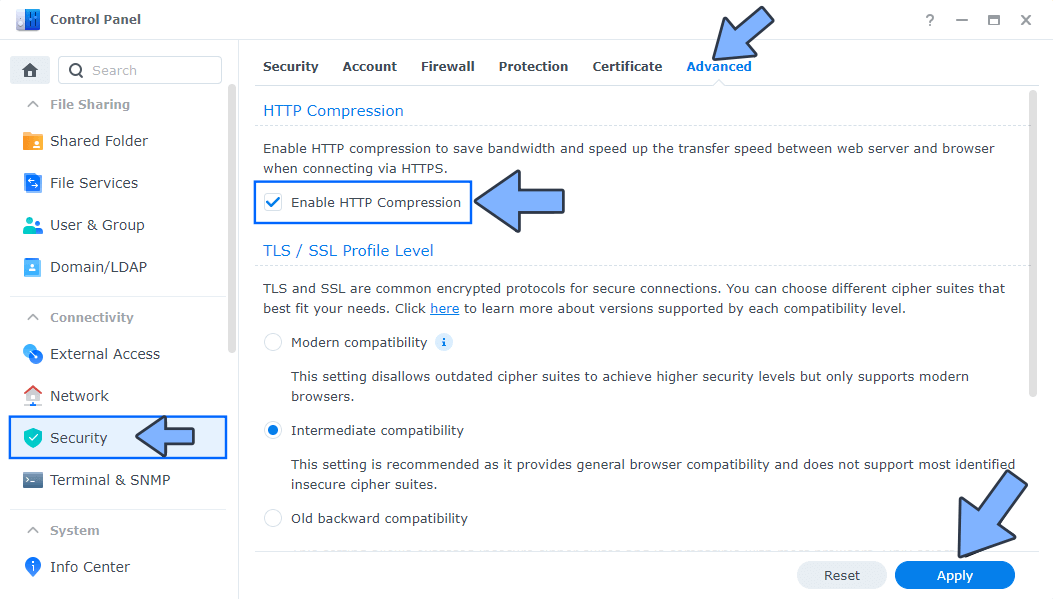
STEP 10
Go to File Station and open the docker folder. Inside the docker folder, create one new folder and name it peertube. Follow the instructions in the image below.
Note: Be careful to enter only lowercase, not uppercase letters.

STEP 11
Now create four new folders inside the peertube folder that you created at STEP 10 and name them config, data, db, redis. Follow the instructions in the image below.
Note: Be careful to enter only lowercase, not uppercase letters.
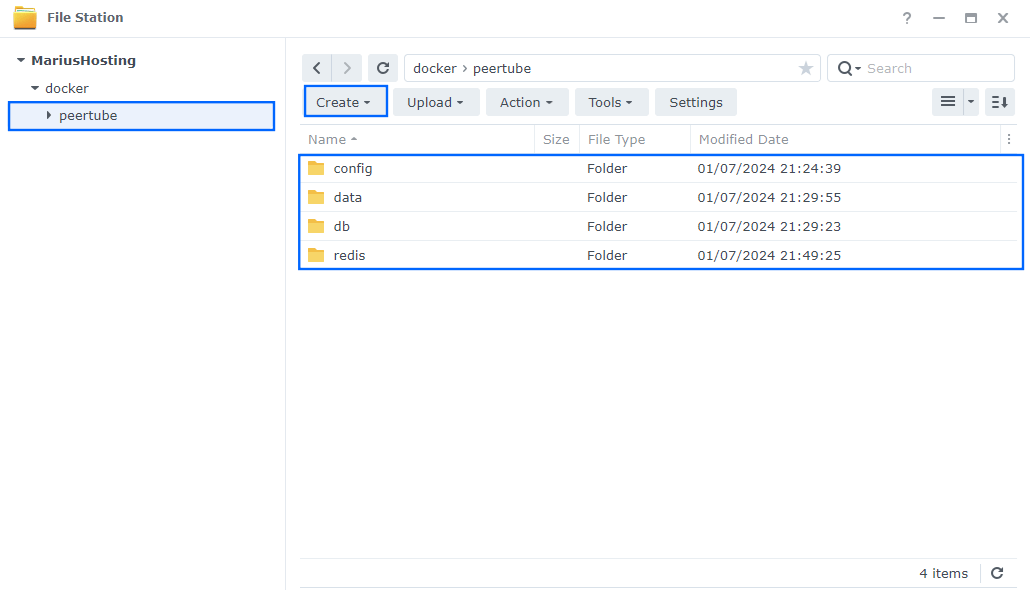
STEP 12
Follow my step by step guide on how to activate SMTP for your Gmail account. This step is mandatory. Note: If you don’t want to use the easiest way for SMTP with Google and you already have SMTP details from your own Mail Server, you can just skip this STEP and use your personalized email SMTP details instead.
STEP 13
Log into Portainer using your username and password. On the left sidebar in Portainer, click on Stacks then + Add stack. Follow the instructions in the image below.

STEP 14
In the Name field type in peertube. Follow the instructions in the image below.
services:
redis:
image: redis:7
command: redis-server --requirepass redispass
container_name: PeerTube-redis
hostname: peertube-redis
security_opt:
- no-new-privileges:true
read_only: true
user: 1026:100
healthcheck:
test: ["CMD-SHELL", "redis-cli ping || exit 1"]
volumes:
- /volume1/docker/peertube/redis:/data:rw
environment:
TZ: Europe/Bucharest
restart: on-failure:5
db:
image: postgres:17
container_name: PeerTube-DB
hostname: peertube-db
security_opt:
- no-new-privileges:true
healthcheck:
test: ["CMD", "pg_isready", "-q", "-d", "$POSTGRES_DB", "-U", "$POSTGRES_USER"]
timeout: 45s
interval: 10s
retries: 10
volumes:
- /volume1/docker/peertube/db:/var/lib/postgresql/data:rw
env_file:
- stack.env
restart: on-failure:5
peertube:
image: chocobozzz/peertube:production-bookworm
container_name: PeerTube
hostname: peertube
security_opt:
- no-new-privileges:true
healthcheck:
test: curl -f http://localhost:9000/ || exit 1
ports:
- 1935:1935 # Comment if you don't want to use the live feature
- 9510:9000
volumes:
- /volume1/docker/peertube/data:/data:rw
- /volume1/docker/peertube/config:/config:rw
env_file:
- stack.env
restart: on-failure:5
depends_on:
redis:
condition: service_healthy
db:
condition: service_healthy
Note: Before you paste the code above in the Web editor area below, change the value numbers for user with your own UID and GID values. (Follow my step by step guide on how to do this.) 1026 is my personal UID value and 100 is my personal GID value. You have to type in your own values.
Note: Before you paste the code above in the Web editor area below, change the value for TZ. (Select your current Time Zone from this list.)
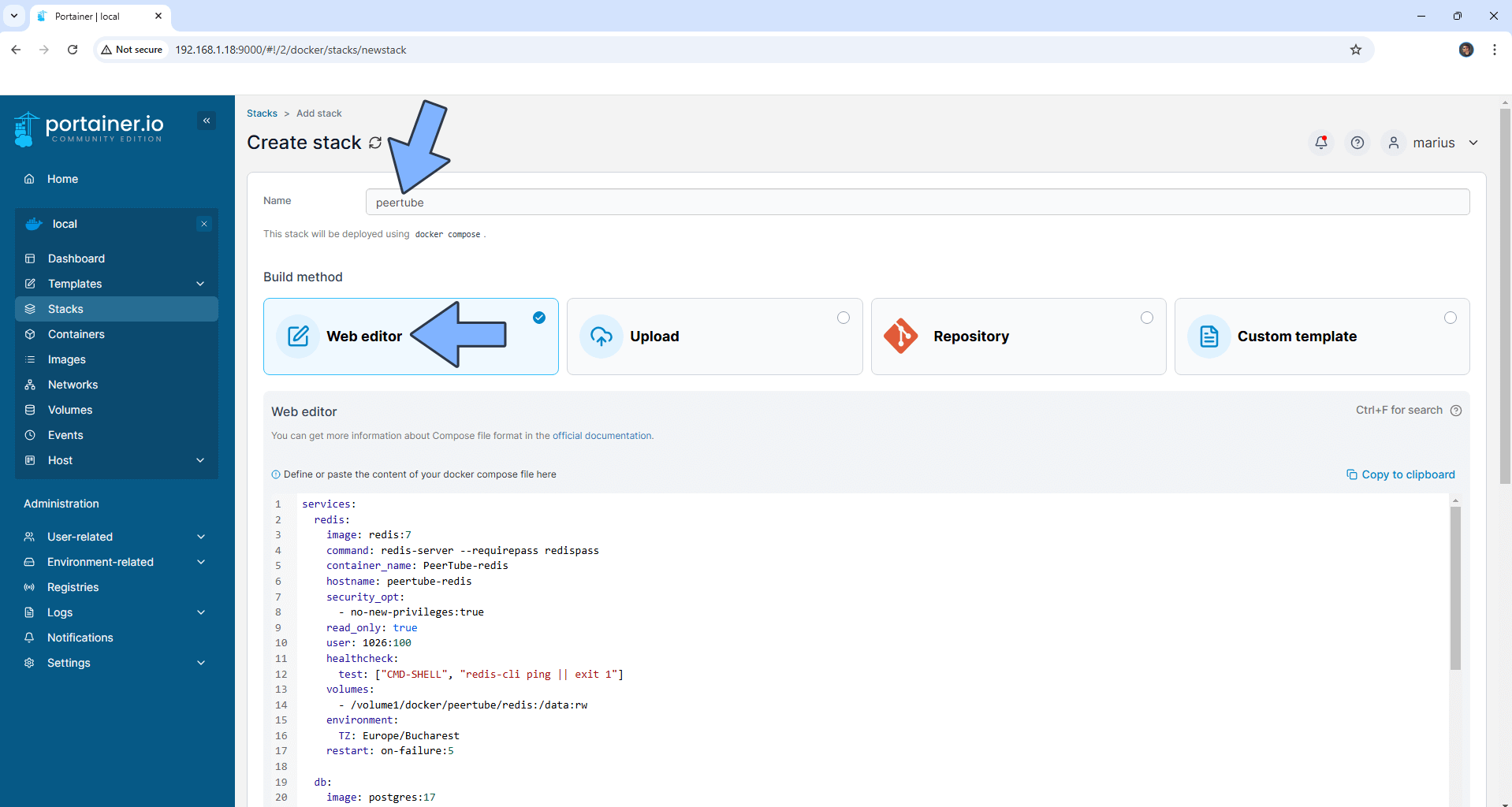
STEP 15
Click the Upload button after Web editor. Download the stack.env file by clicking the blue link below and then upload it from your computer in the “Load variables from .env files“. Follow the instructions in the image below. 🔒Note: Support my work to unlock the password. You can use this password to download any file on mariushosting forever!
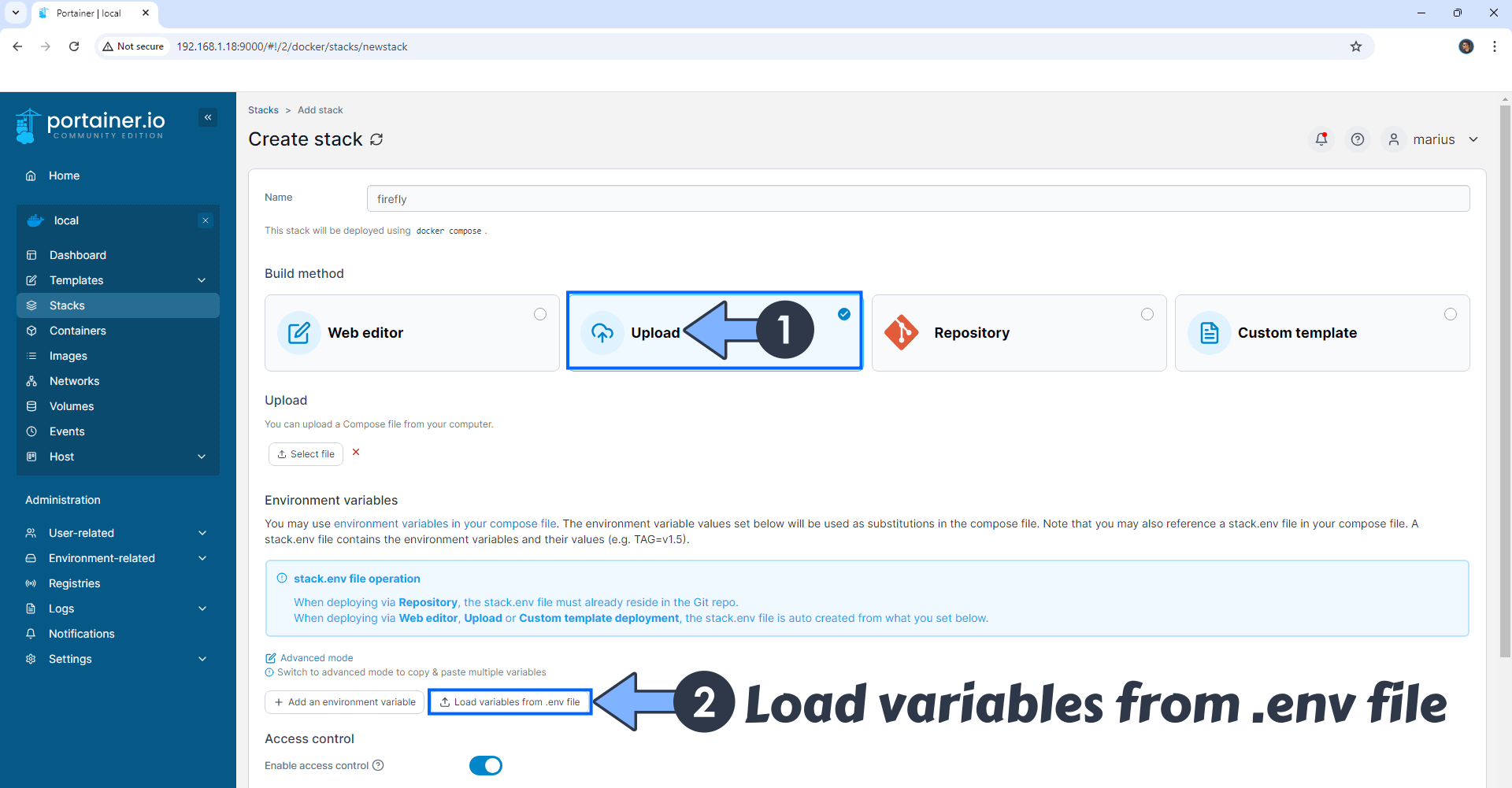
STEP 16
Note: On the Environment variables change the value for PEERTUBE_WEBSERVER_HOSTNAME. Type in your own synology.me DDNS that you have previously created at STEP 6 without https at the beginning.
Note: On the Environment variables change the value for PEERTUBE_ADMIN_EMAIL. Type in your own Email Address. This email will be your admin email and you will need it at STEP 26.
Note: On the Environment variables change the value for PEERTUBE_SMTP_USERNAME. Type in your own GMAIL Address. STEP 12
Note: On the Environment variables change the value for PEERTUBE_SMTP_PASSWORD. Type in your own GMAIL APP PASSWORD. STEP 12
Note: On the Environment variables change the value for PEERTUBE_SMTP_FROM. Type in your own GMAIL Address. STEP 12
Warning: Do not change any of the other values.
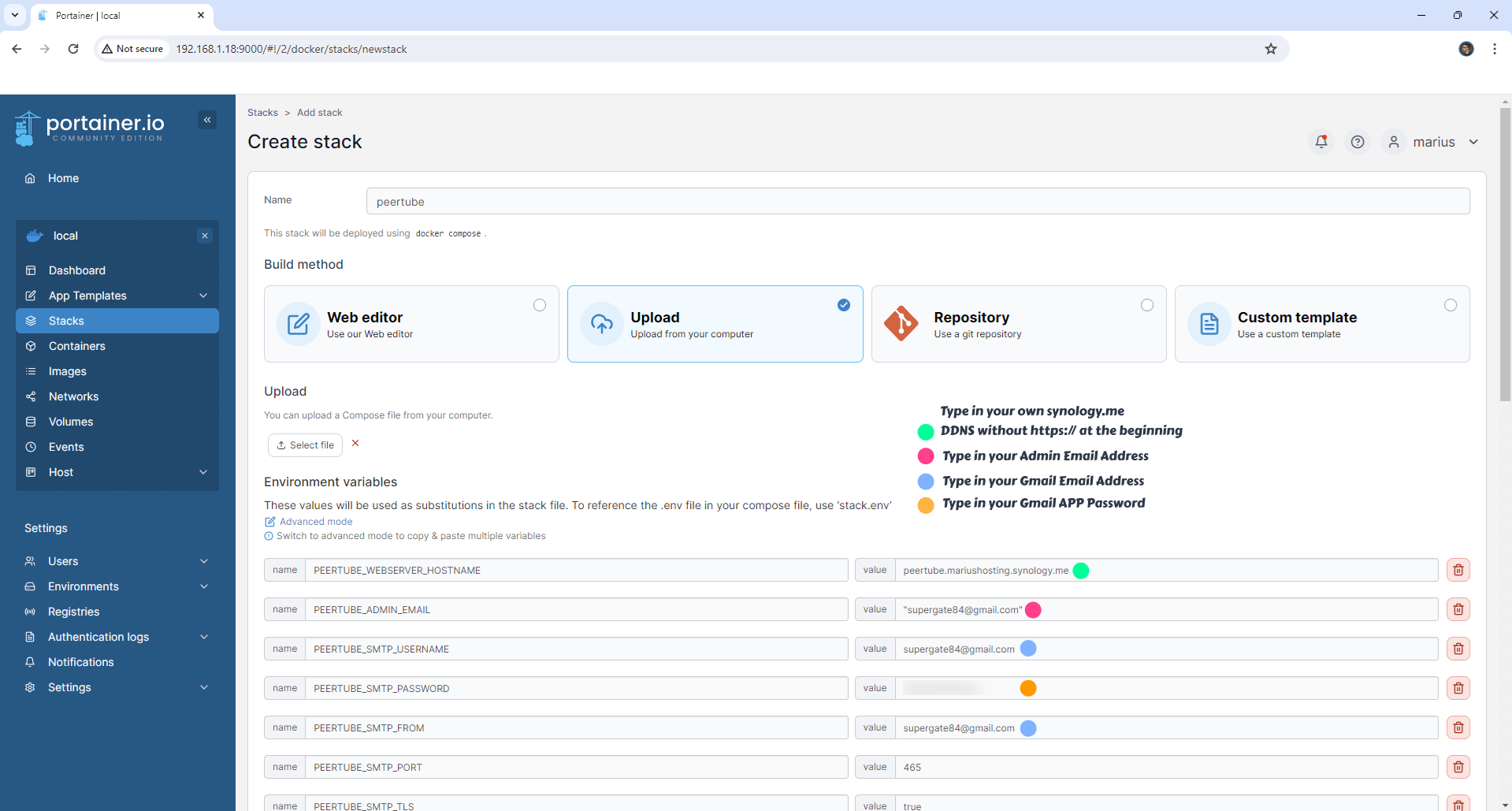
STEP 17
After you make the changes, click the Web editor button. Follow the instructions in the image below.
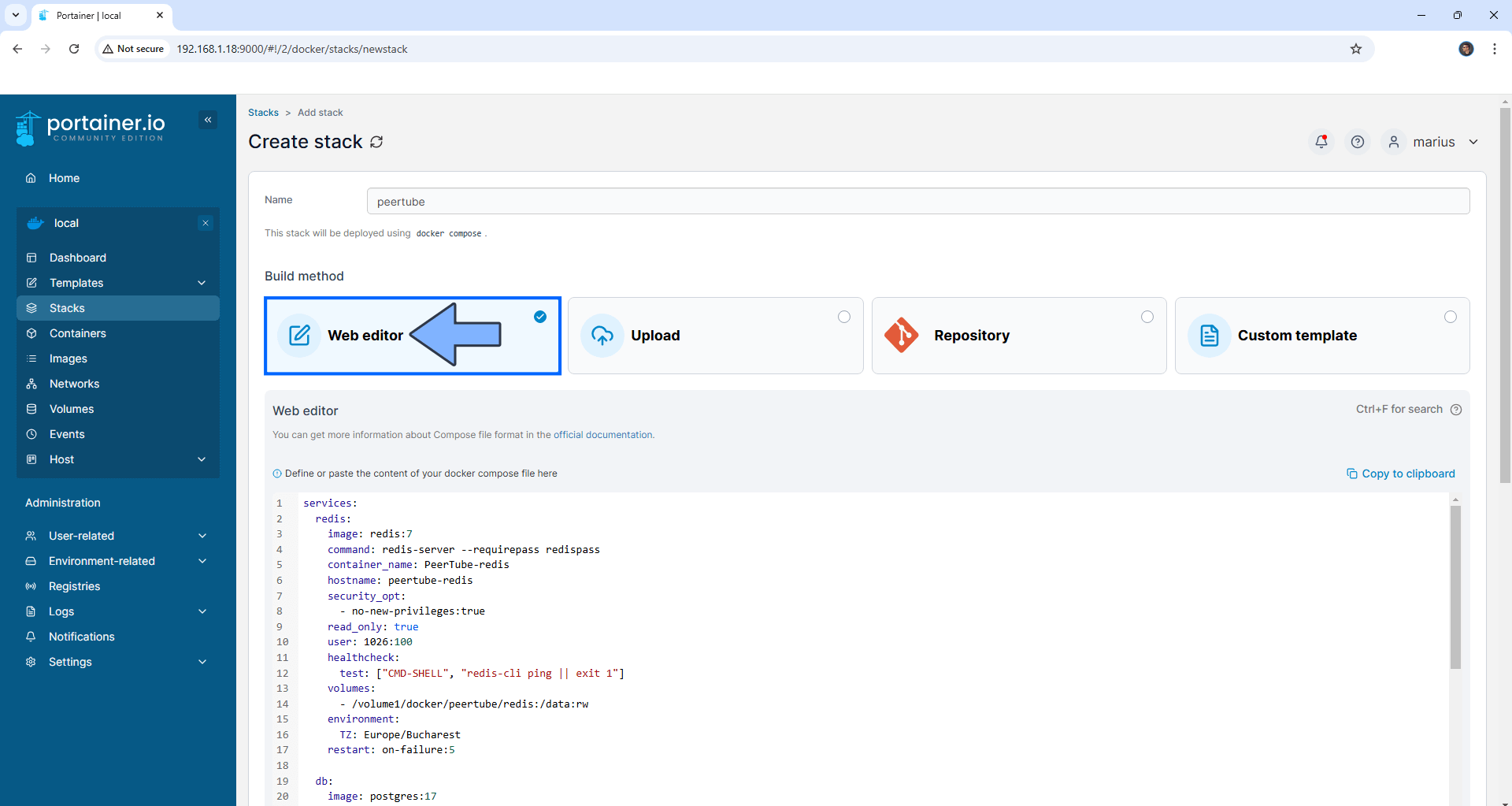
STEP 18
Scroll down on the page until you see a button named Deploy the stack. Click on it. Follow the instructions in the image below. The installation process can take up to a few minutes. It will depend on your Internet speed connection.
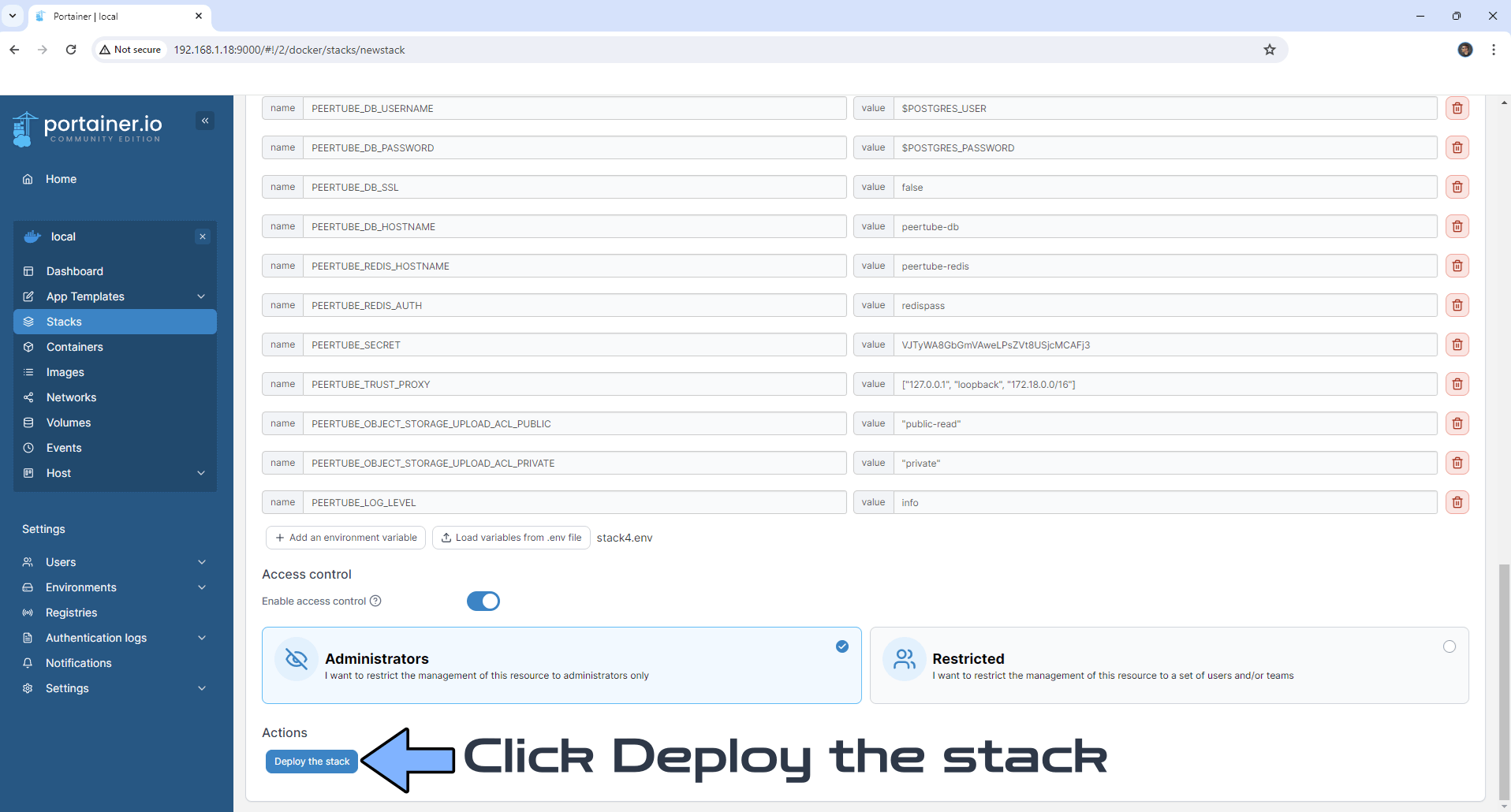
STEP 19
If everything goes right, you will see the following message at the top right of your screen: “Success Stack successfully deployed“.
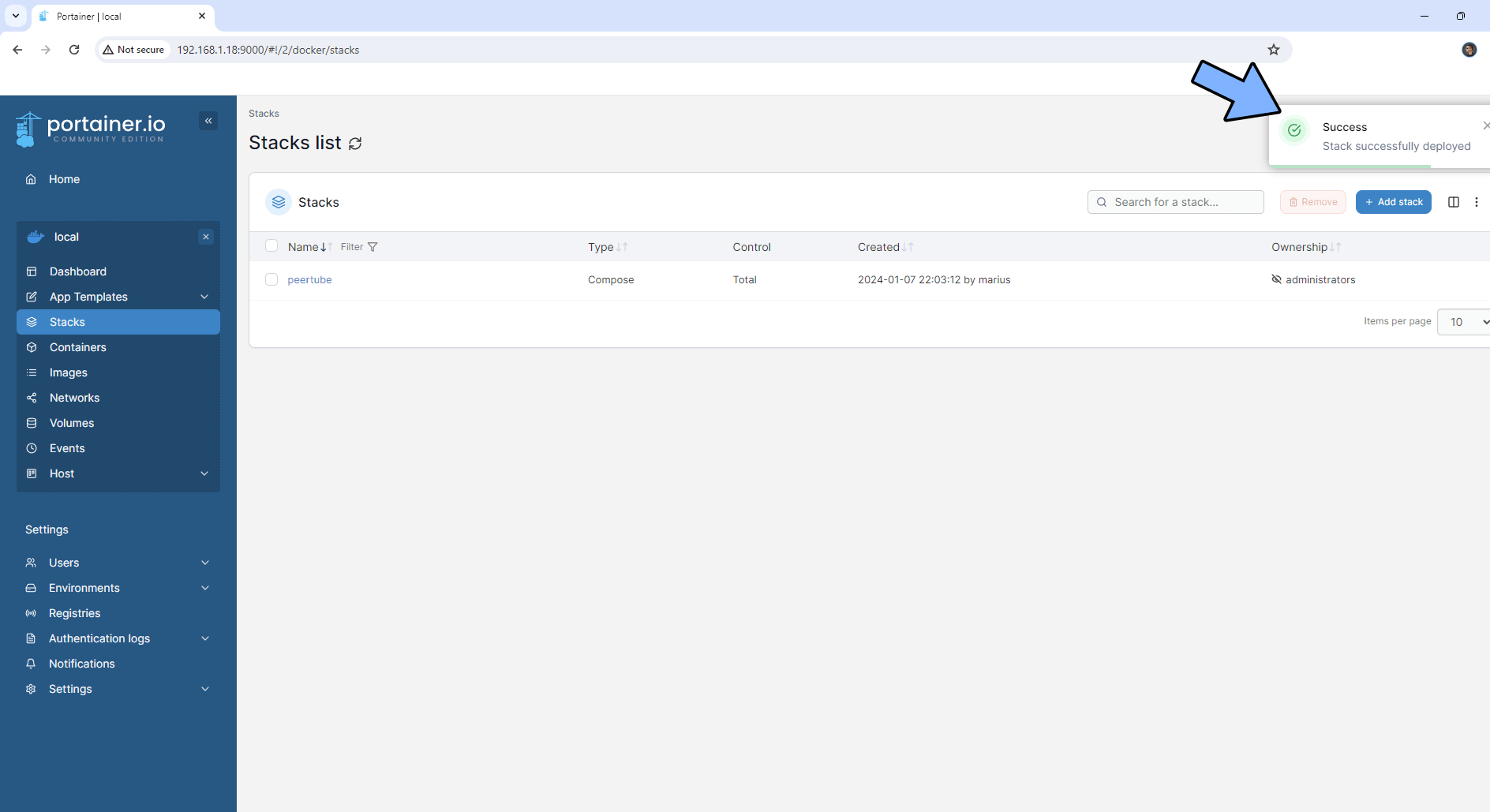
STEP 20
On the left sidebar in Portainer, click Containers. Identify your PeerTube instance, then click on the little terminal icon. Follow the instructions in the image below.
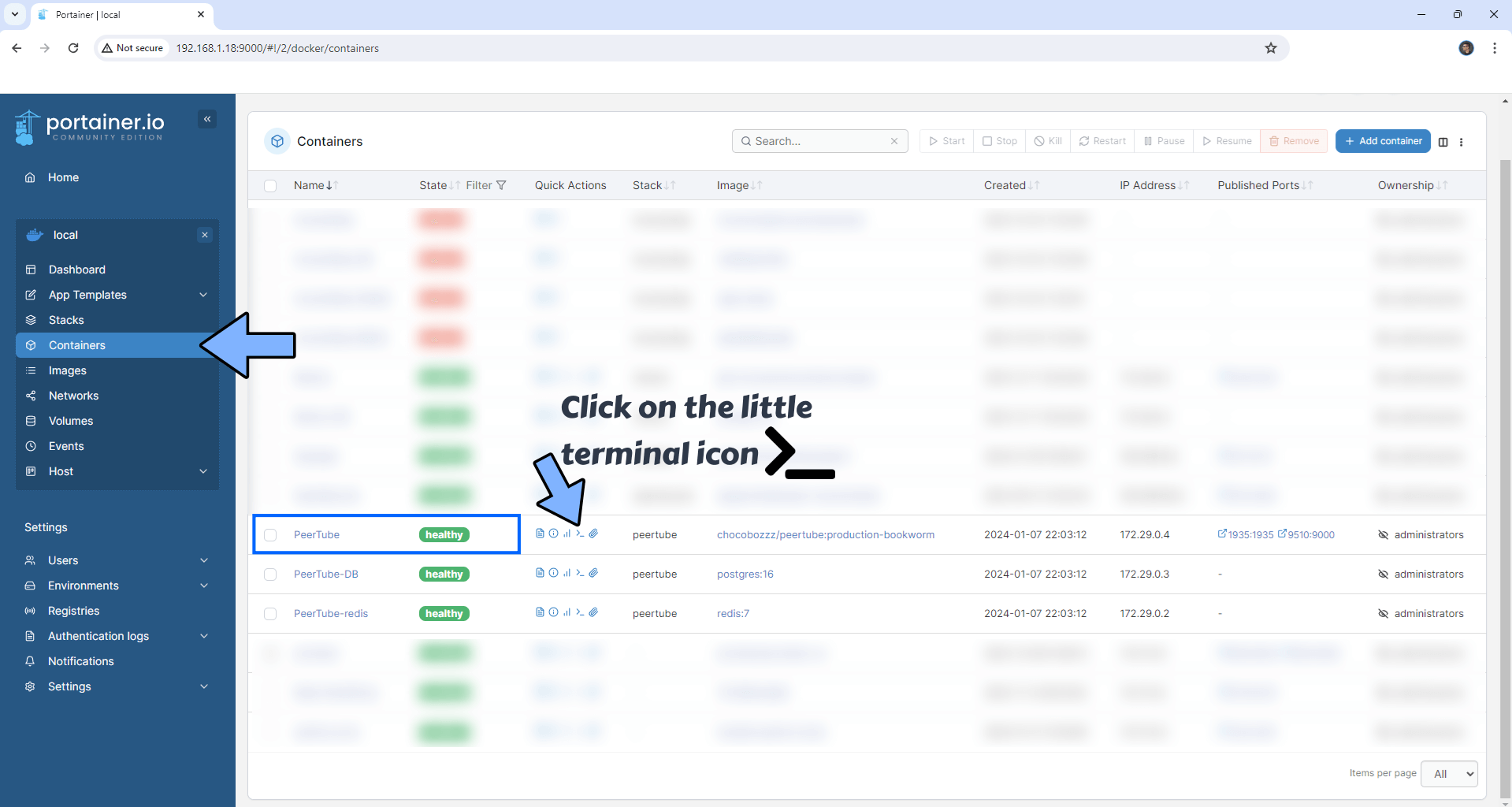
STEP 21
After you click on the little terminal icon at STEP 20, a new page will open. Click Connect. Follow the instructions in the image below.
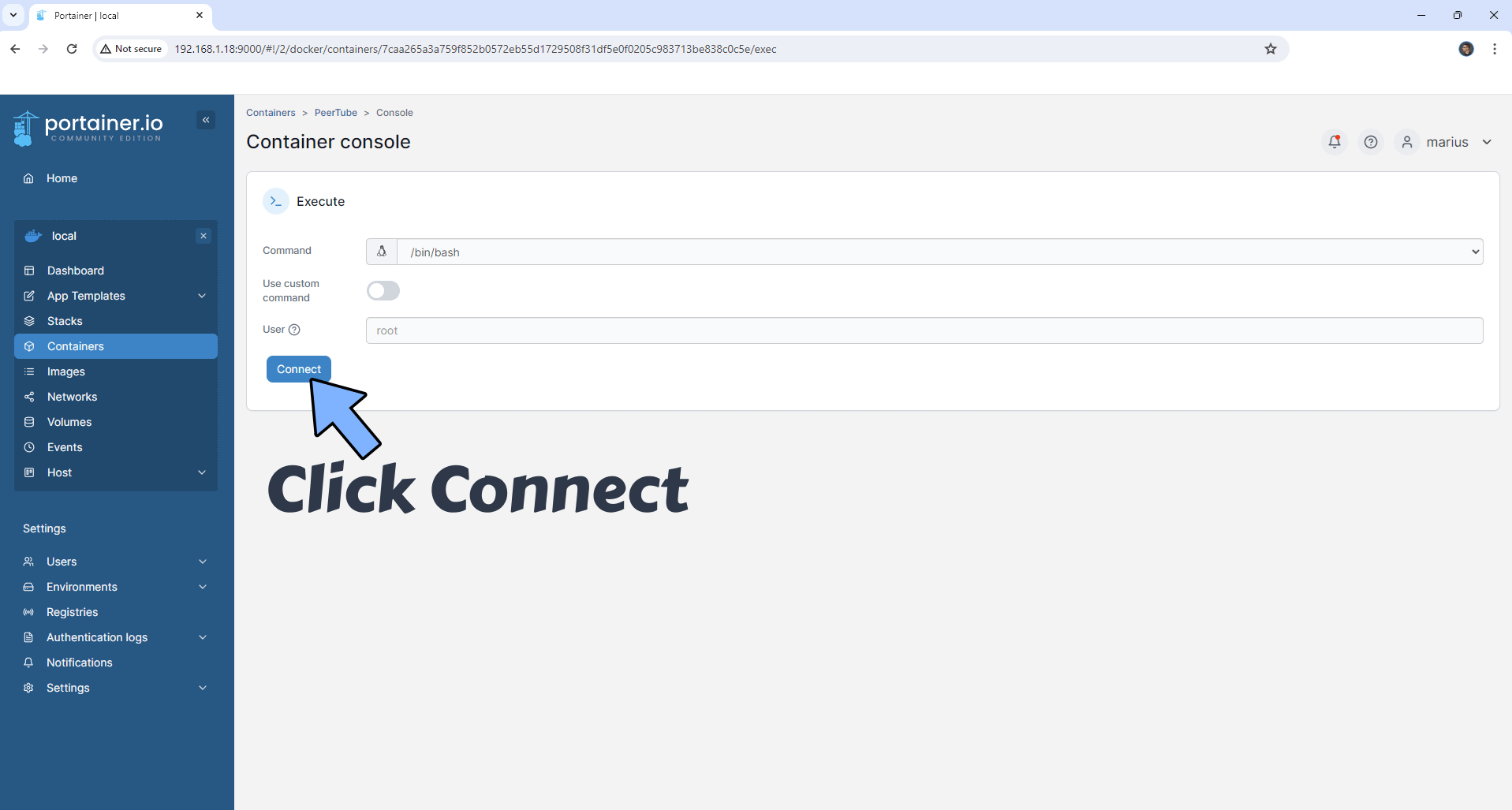
STEP 22
After you click Connect at STEP 21, a Console will open. Copy Paste the code below. Once the code is inserted, confirm by pressing Enter on your keyboard.
npm run reset-password -- -u root
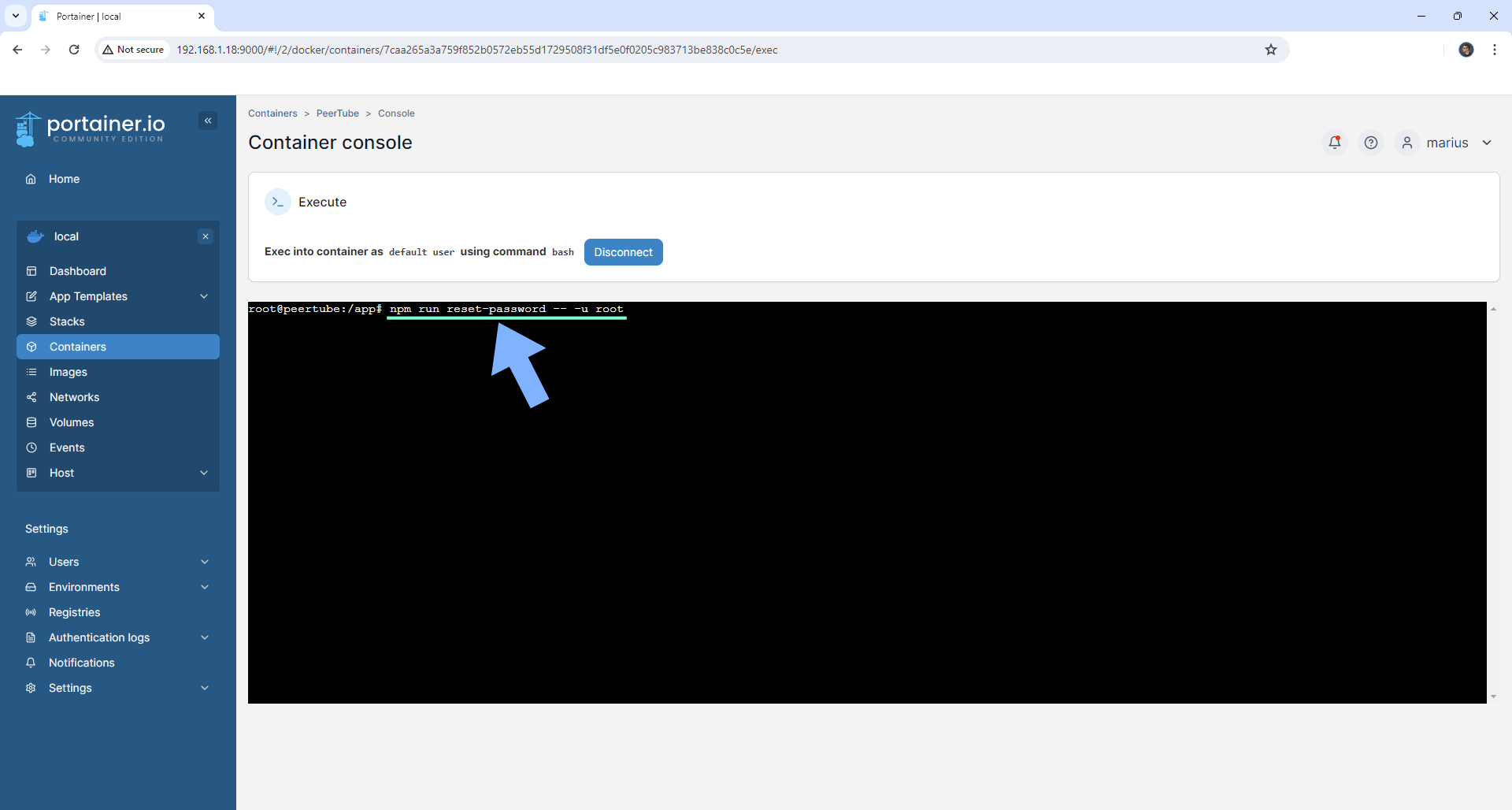
STEP 23
After some seconds, you will get a new password request. Type in your own password. Once the password is inserted, confirm by pressing Enter on your keyboard. Note: You won’t see the password you are typing in. You will need this password later at STEP 27.
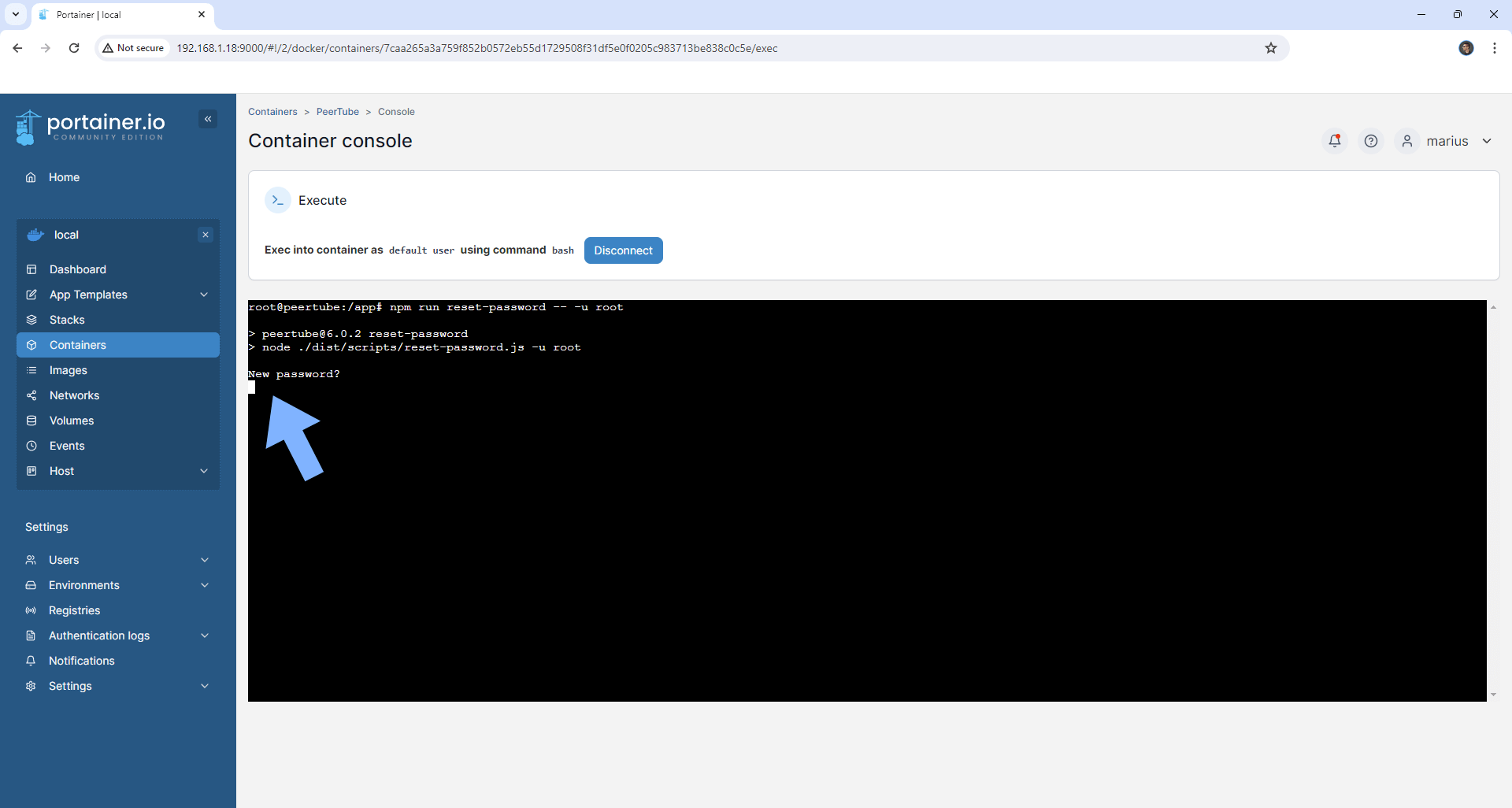
STEP 24
After a few seconds, you will get a message in the terminal that says: “User password updated“. Follow the instructions in the image below.
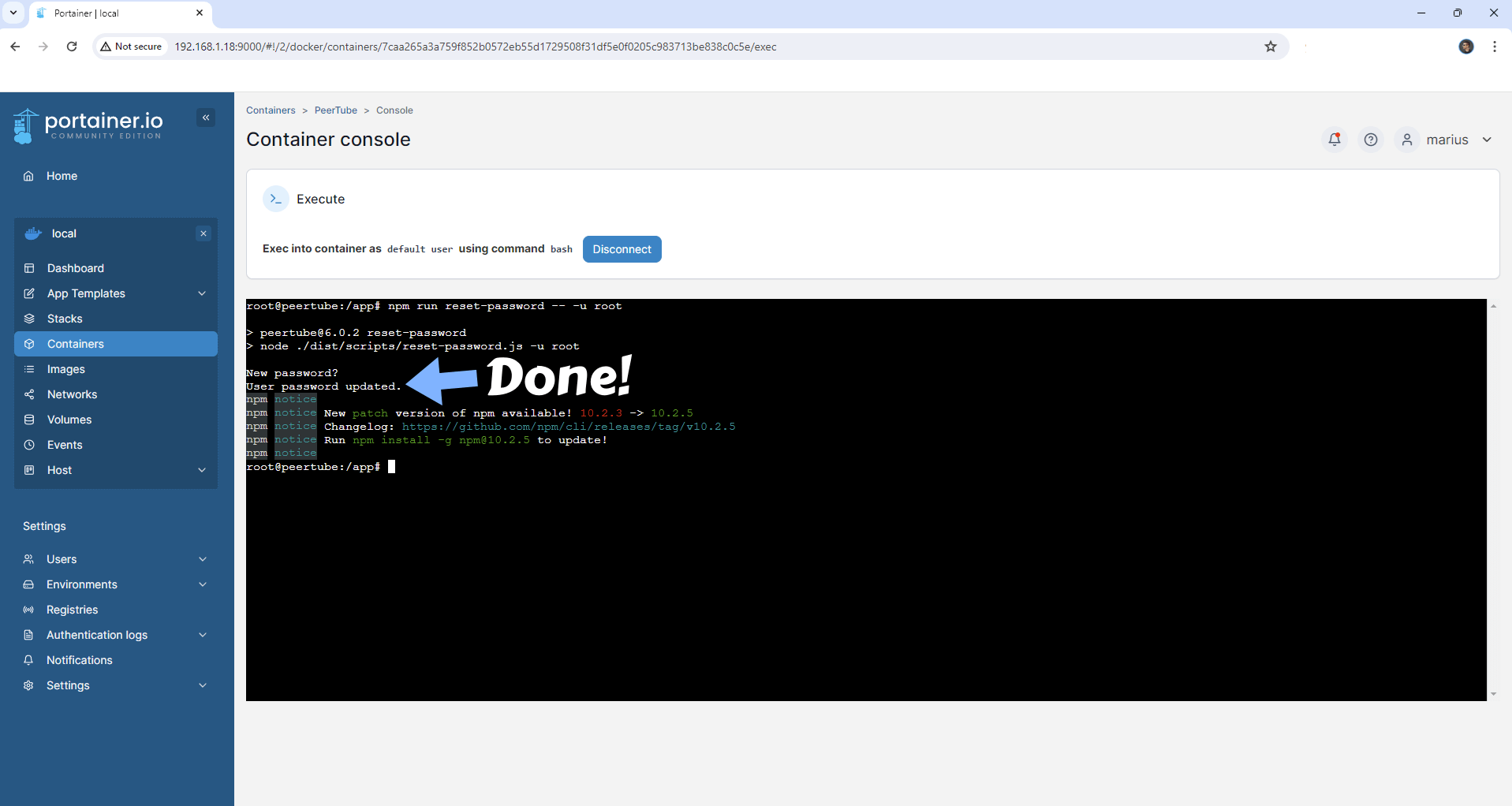
STEP 25
🟢Please Support My work by Making a Donation. Almost 99,9% of the people that install something using my guides forget to support my work, or just ignore STEP 1. I’ve been very honest about this aspect of my work since the beginning: I don’t run any ADS, I don’t require subscriptions, paid or otherwise, I don’t collect IPs, emails, and I don’t have any referral links from Amazon or other merchants. I also don’t have any POP-UPs or COOKIES. I have repeatedly been told over the years how much I have contributed to the community. It’s something I love doing and have been honest about my passion since the beginning. But I also Need The Community to Support me Back to be able to continue doing this work.
STEP 26
Now open your browser and type in your HTTPS/SSL certificate like this https://peertube.yourname.synology.me that you have previously created at STEP 6. In my case it’s https://peertube.mariushosting.synology.me If everything goes right, you will see the main PeerTube page. On the left sidebar click Login. Follow the instructions in the image below.
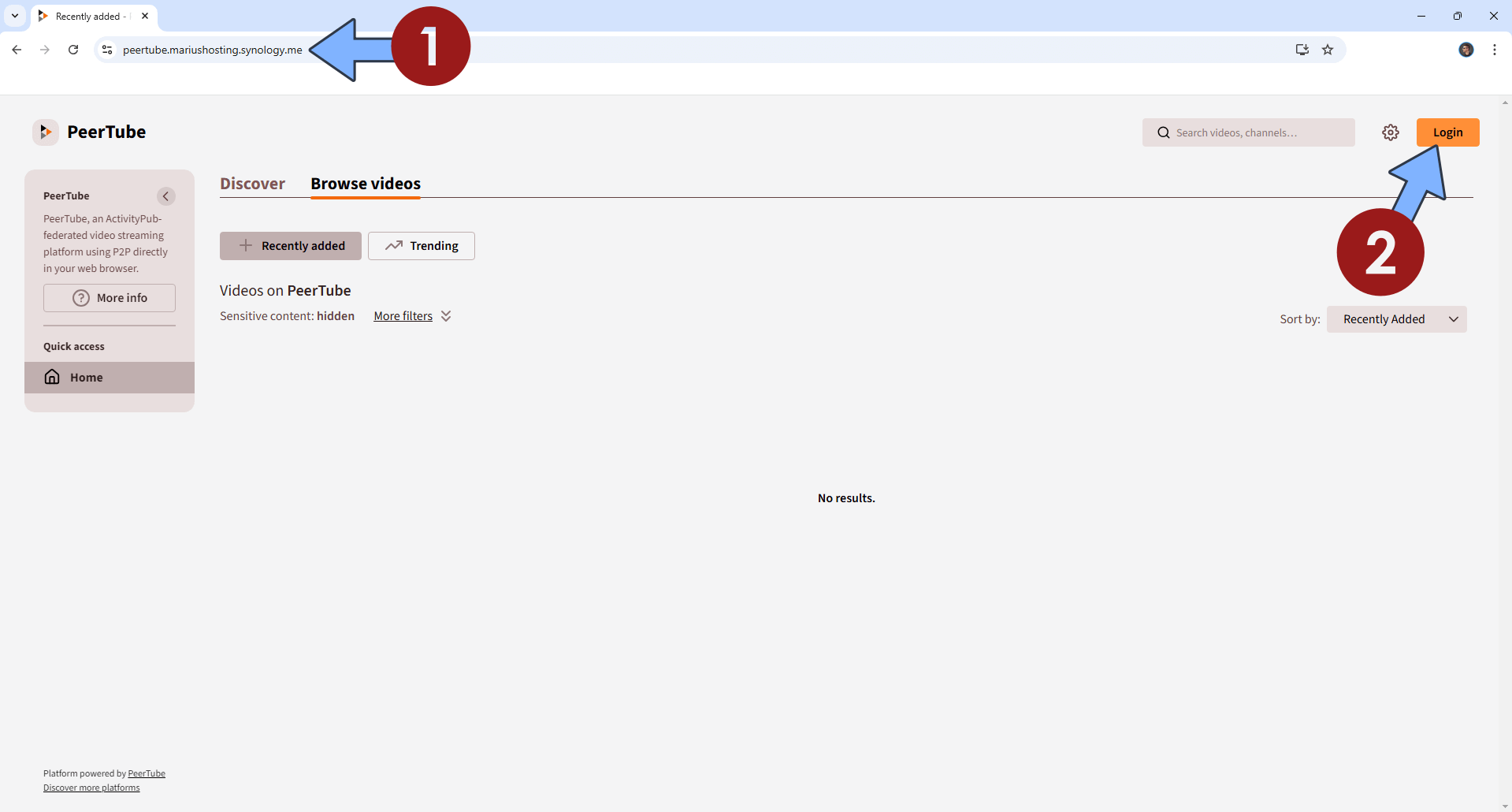
STEP 27
Type in your own PEERTUBE_ADMIN_EMAIL that you have previously created at STEP 16, and your own Password that you have previously created at STEP 23. Click Login. Follow the instructions in the image below.
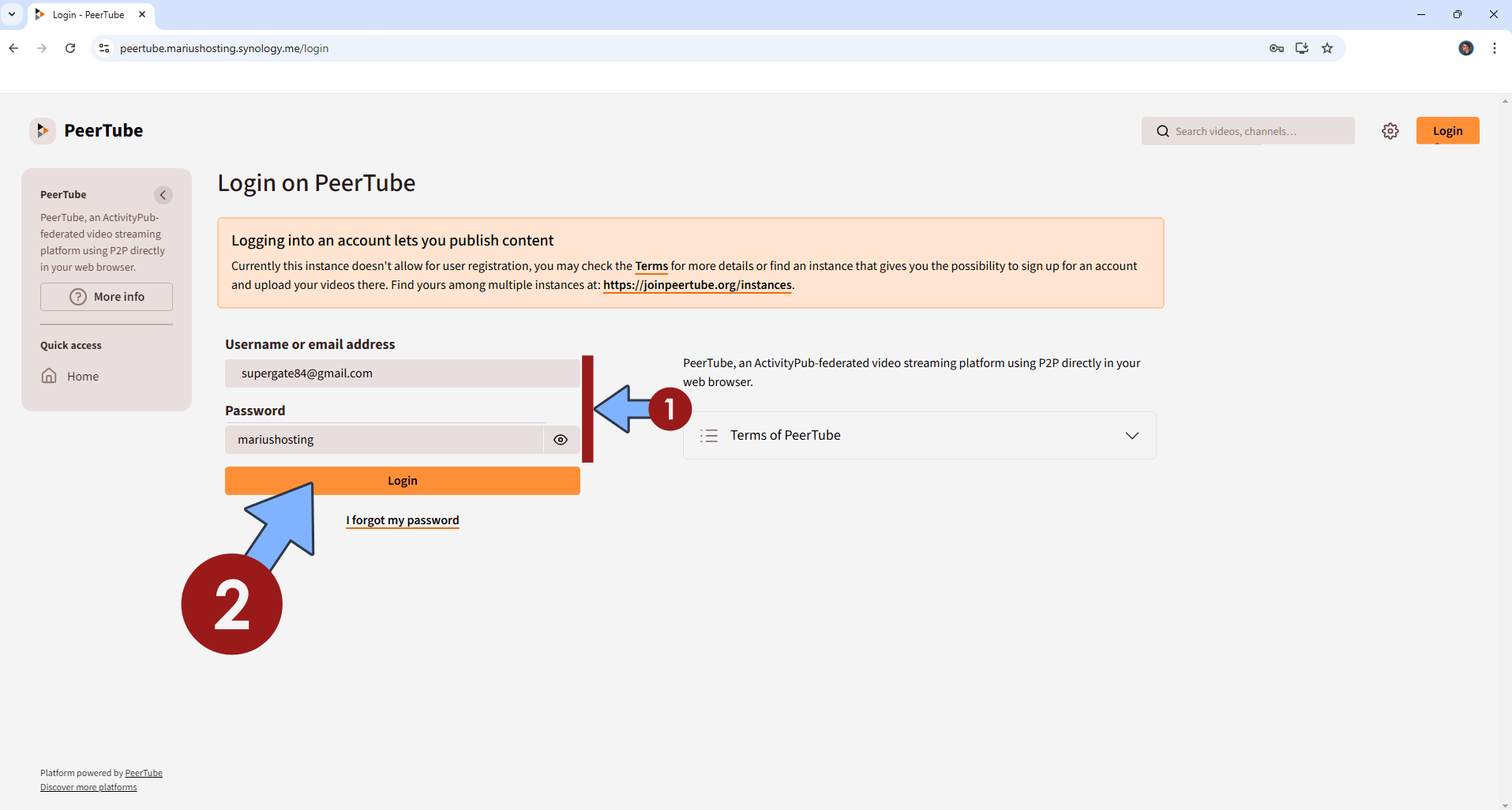
STEP 28
Your Administration dashboard at a glance!
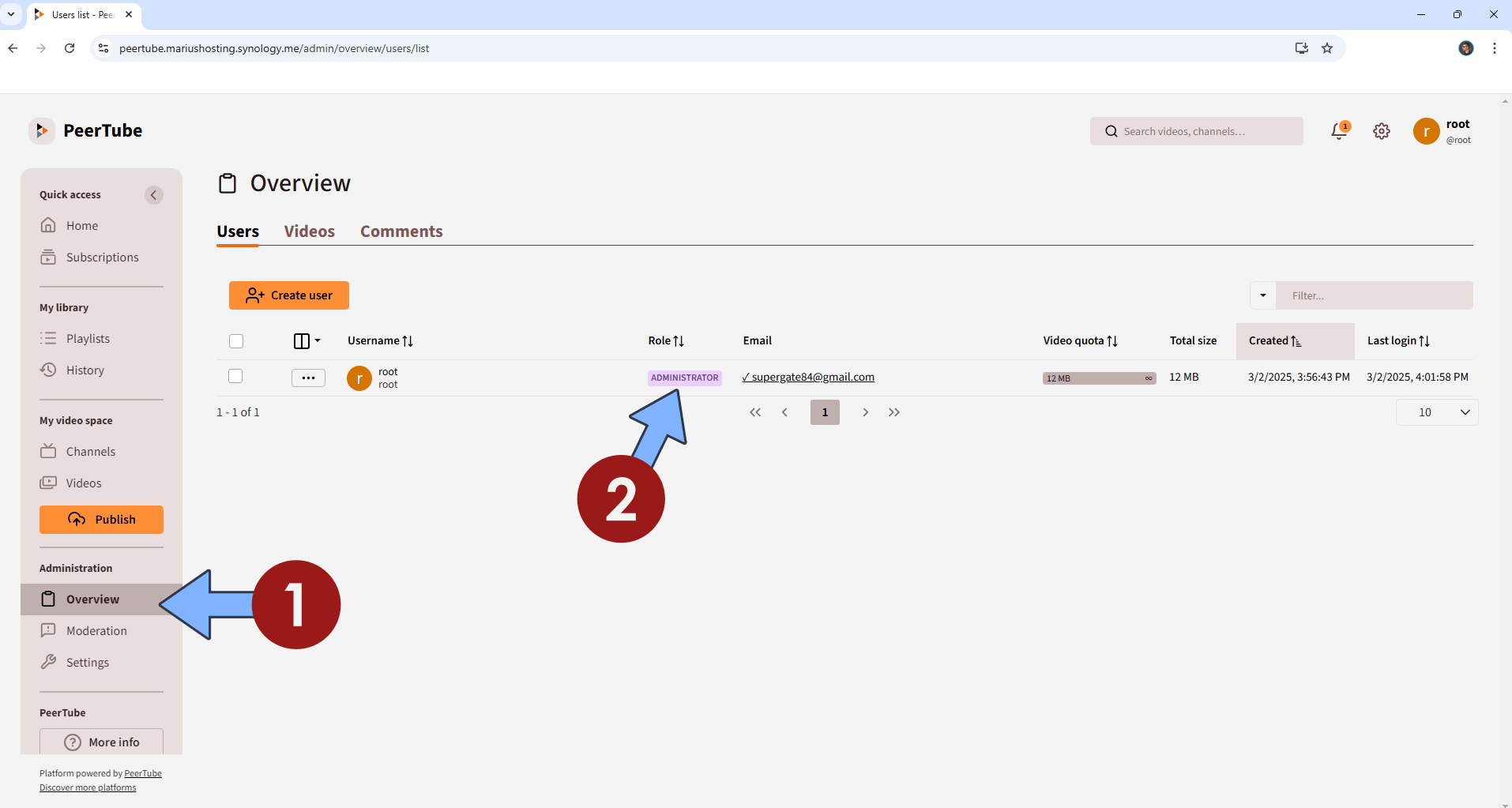
STEP 29
Upload your videos! Follow the instructions in the image below!
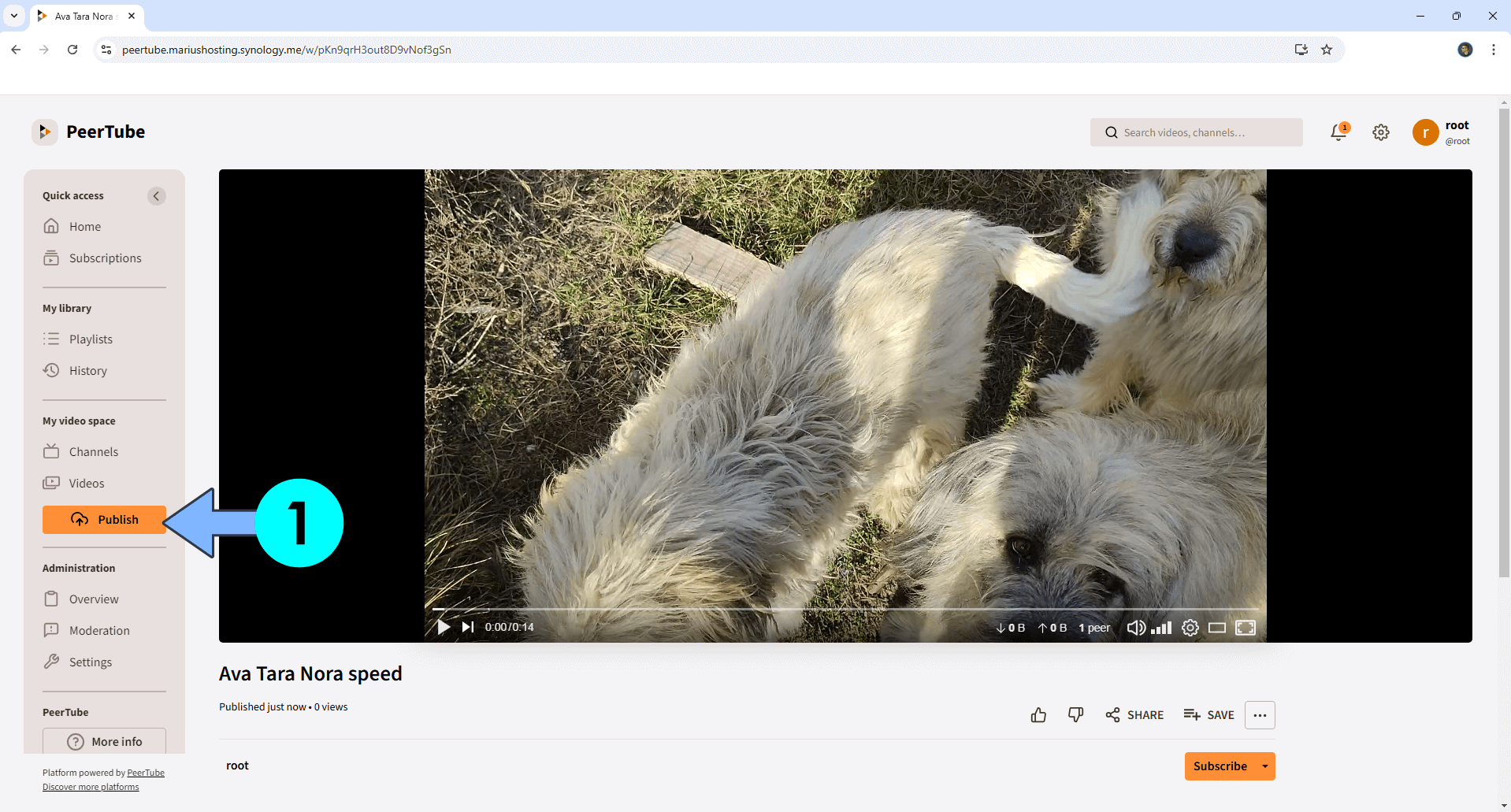
STEP 30
At the top right of the page, click root then Manage my account. Click the Settings tab, then scroll down the page. Follow the instructions in the image below.
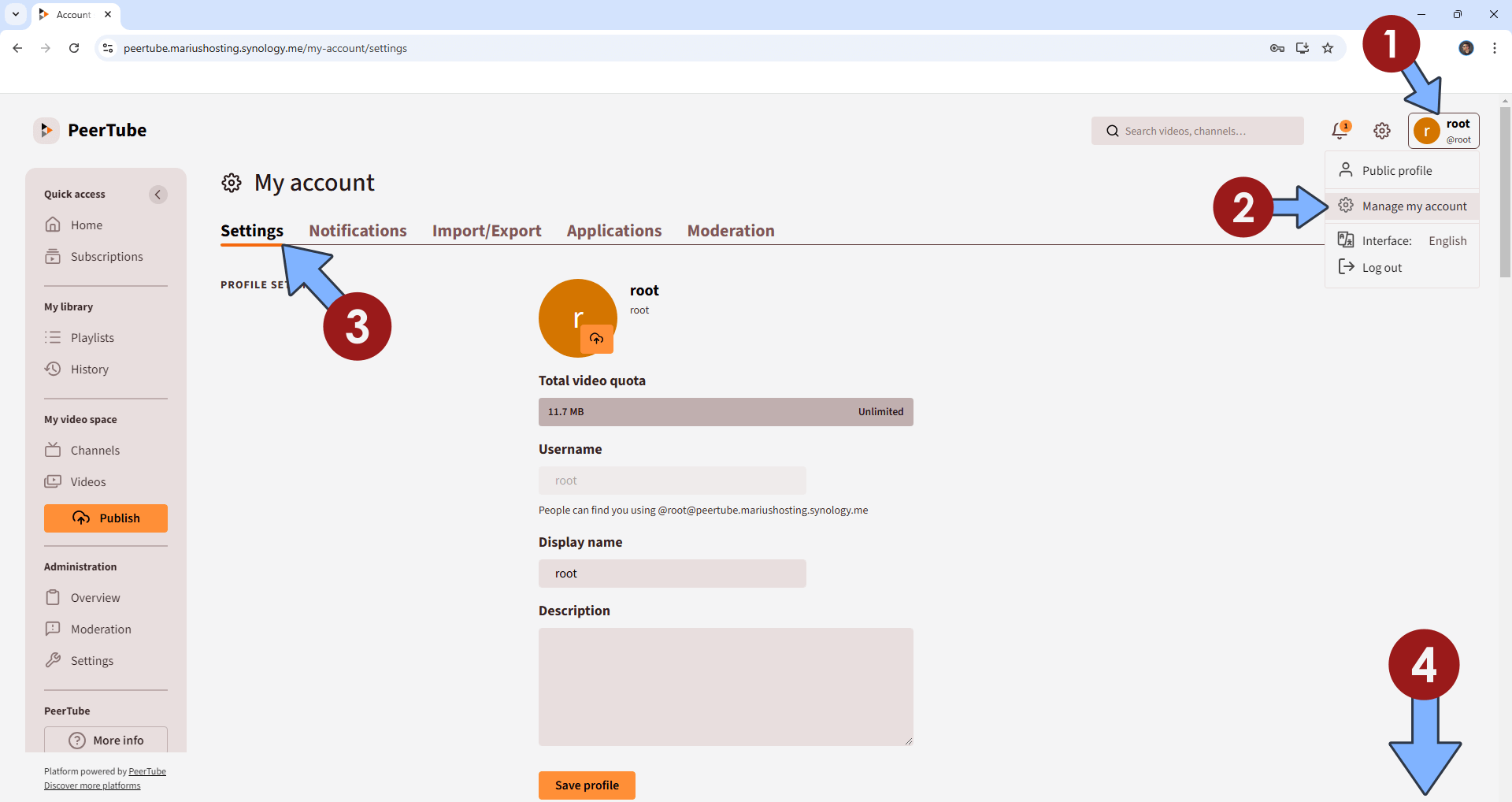
STEP 31
Select your favorite theme, then click Save interface settings to save the settings.
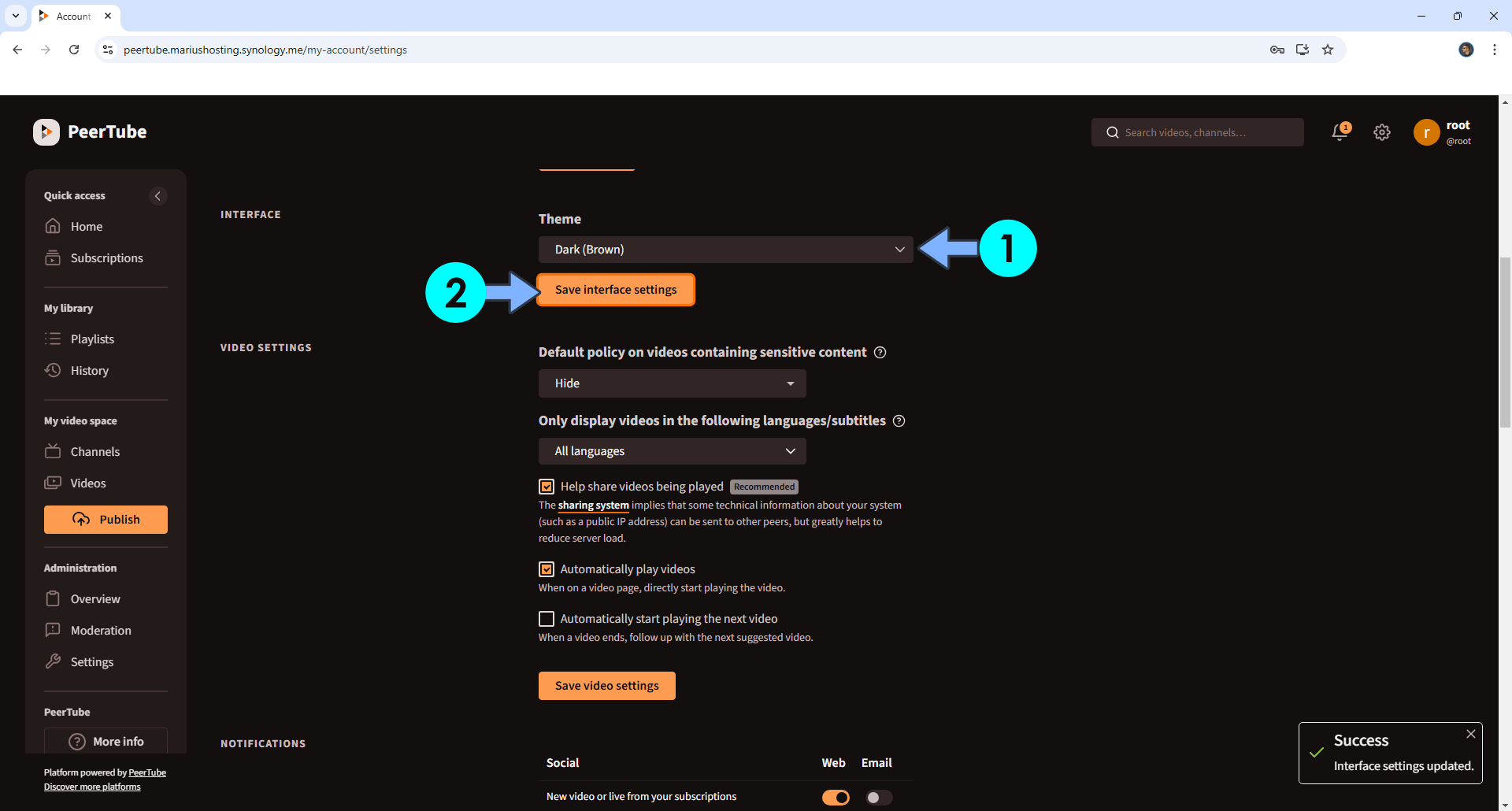
STEP 32
Your PeerTube instance at a glance!
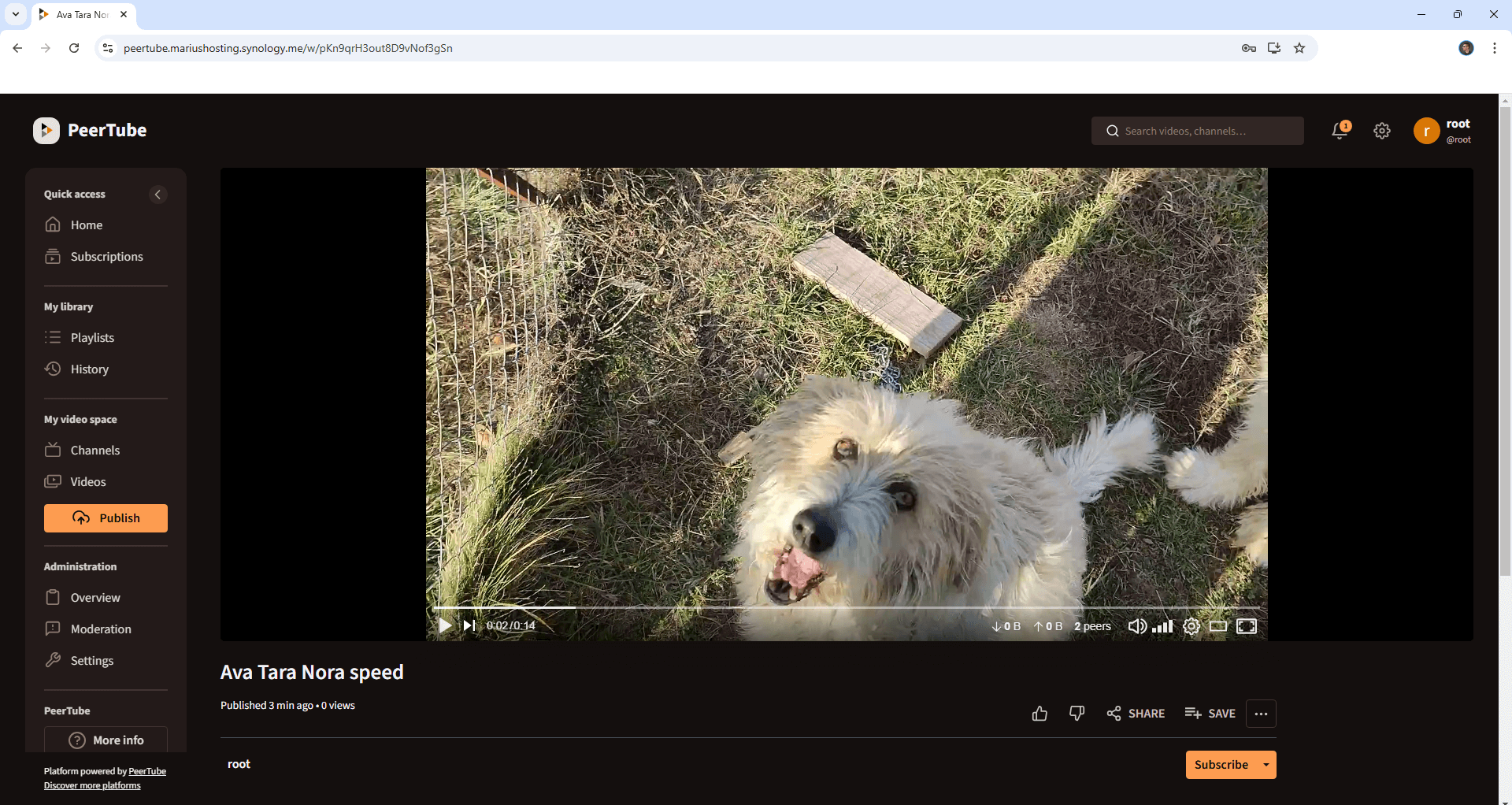
Enjoy PeerTube!
If you encounter issues by using this container, make sure to check out the Common Docker issues article.
Note: Find out how to update the PeerTube container with the latest image.
Note: How to Back Up Docker Containers on your Synology NAS.
Note: Can I run Docker on my Synology NAS? See the supported models.
Note: How to Free Disk Space on Your NAS if You Run Docker.
Note: How to Schedule Start & Stop For Docker Containers.
Note: How to Activate Email Notifications.
Note: How to Add Access Control Profile on Your NAS.
Note: How to Change Docker Containers Restart Policy.
Note: How to Use Docker Containers With VPN.
Note: Convert Docker Run Into Docker Compose.
Note: How to Clean Docker.
Note: How to Clean Docker Automatically.
Note: Best Practices When Using Docker and DDNS.
Note: Some Docker Containers Need WebSocket.
Note: Find out the Best NAS Models For Docker.
Note: Activate Gmail SMTP For Docker Containers.
This post was updated on Sunday / June 22nd, 2025 at 10:34 PM
